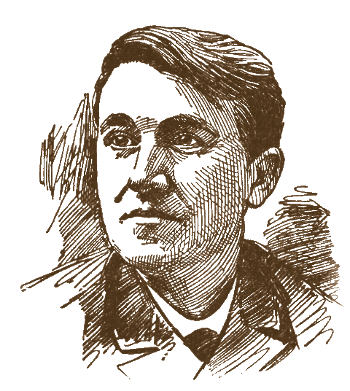Creativity
January 3, 2014
History celebrates
creativity, but what's the condition of the creative individual in his own time? The reality appears to be much more like
Cassandra, who had the gift of
prophecy, but the curse of never being believed. There's also the
Biblical quotation in
Mark 6:4 that "A prophet is not without honor except in his hometown and among his own relatives and in his own household."

Cassandra
Cassandra foretold the fall of Troy.
No one would believe her, since the god, Apollo, cursed her so that her prophesies were never believed.
(Portion of an 1898 illustration by Evelyn De Morgan (1855–1919), via Wikimedia Commons.)
People generally prefer the tried-and-true to the truly
novel. One of my own experiences in this regard was when I was taking a
solid geometry course as a
senior in
high school. Our first
test asked for the
proof of some simple
theorem. I answered with a proof that wasn't the example given in our
textbook, and the proof was marked wrong by the
teacher. I dropped the course that same day.
One example in
science of how far people will go to preserve the old, rather than attempt something new, is the
geocentric model of the
solar system. The original model had the
planets and the
Sun move in perfect
circles around the
Earth. When the actual
orbits were found to deviate from circles, and planets were even seen to move in a
retrograde fashion, a change was needed.
In order keep geocentrism, the
Ptolomaic model was proposed. In that model, there was still the notion of perfect circular motion, but ancient
astronomers introduced
epicycles, which were circular orbits about other circular orbits. One modern astronomer remarked that if
Copernicus hadn't come along, we would be reading papers about eighteen epicycle
fits to the orbit of
Jupiter.
Now that we have
ubiquitous computing, there's a trend in which an answer is more important than a solution. In the old model of
scientific knowledge,
theory guided
experiment, which guided better theory. Today, many
technology companies are satisfied with developing
heuristics, such as the
design of experiments methodology (DOE), rather than theory. A few
graphs generated by
multidimensional linear regression is today's true path to knowledge.
Creativity was always supposed to derive from the efforts of an individual. I gave the example of Copernicus, above, and we have the recent examples of
Einstein,
Bohr, and the many
physicists who created
modern physics. In my career in
industrial research, my role shifted from an individual contributor to one of
"project leader" or "project member" on team efforts.
Invention was made by a team, not by an individual.
As it turns out, team invention is actually better. A study that looked at a half million inventions found that
"Individuals working alone, especially those without affiliation to organizations, are less likely to achieve breakthroughs and more likely to invent particularly poor outcomes."[1]
The broader
experience base of a team helps in creating breakthroughs, although its true worth is in discarding bad solutions.[1]
A recent study of
US and
Japanese patents found that the team approach works well only when the team is fresh. Team performance on invention degrades with repeat collaboration, and the study authors suggest that this effect may be true when teams collaborate on other creative projects.[2]

Although Thomas Edison (pictured) made a point of being the sole named inventor on many patents, such inventions were usually the work of a huge technical team.
(Illustration from The New Student's Reference Work, Chandler B. Beach and Frank Morton Mcmurry, Eds., F. E. Compton And Company (Chicago, 1914), via Wikimedia Commons.)
In our
affluent society, creativity is valued as a means of inventing the next
electronic gizmo; but, the original purpose of creativity, and perhaps the reason why we've evolved to invent such devices, is its
survival advantage. It's apparent that there was an uptick in creativity about 50,000 years ago in the
Upper Palaeolithic Revolution, which finally went into overdrive in the
Neolithic Revolution.
During the
Neolithic, innovation in the
cultivation and storage of
food transformed human society from its
hunter-gatherer existence to a diverse society that included
tradesmen and
artisans. A recent
computational model suggests that the rise in human creativity came about through the capacity for
recursive recall; that is, single step activities became chained into more complex activities.[3]
Although creativity has had an apparent evolutionary advantage, people still reject the creative for the tried-and-true.
Jessica Olien, in a recent article in
Slate,[4] references an article in
Psychological Science that seeks to explain why this is true. The full text of Psychological Science article, "The Bias Against Creativity - Why People Desire but Reject Creative Ideas," by
Jennifer S. Mueller, now at the
University of San Diego,
Shimul Melwani of the
University of North Carolina (Chapel Hill, NC), and
Jack A. Goncalo of
Cornell University (Ithaca, New York), is freely available online.[5]
According to their paper, people reject creative solutions since they have an unconscious desire to minimize
risk. Creative individuals must hurdle this concealed barrier if they want their innovative ideas to be accepted.[5] In her Slate article, Olien makes extended reference to a 1995 paper on the rejection of creativity by
Barry M. Staw, Lorraine Tyson Mitchell Chair in Leadership and Communication of the
Haas School of Business at the
University of California, Berkeley.[6]
As Staw writes, we don't celebrate creative individuals, we celebrate the successful creative individuals. When your
iPhone is in hand, it's easy to celebrate
Steve Jobs. Most people are "satisfiers," rather than searchers for
optimal solutions. They see that most scientists are in the practice of what
Thomas Kuhn called "
normal science," which is not very exciting stuff, so they choose not to become scientists.[6]
The reason why there are few creative people in
corporations is because they have
personality traits that are selected-out. In the mindset of the
manager and
human resources department, it's better to weed these people out early, so there won't be any trouble. However, the problem such corporations face is that they manufacture market-safe products in a world filled with other similar products. Says Staw, "...innovation requires investing in losers as well as winners..."[6]
Number 124 in
Maxims for Revolutionists (1903) by
London School of Economics co-founder,
George Bernard Shaw, is the following:
"The reasonable man adapts himself to the world: the unreasonable one persists in trying to adapt the world to himself. Therefore all progress depends on the unreasonable man."
References:
- J. Singh and L. Fleming, "Lone Inventors as Sources of Breakthroughs: Myth or Reality?" Management Science, vol. 56, no. 1 (January, 2010), pp. 41-56.
- Hiroyasu Inoue and Yang-Yu Liu, "Revealing the intricate effect of collaboration on innovation," arXiv Preprint Server, September 9, 2013.
- Liane Gabora and Steve DiPaola, "How Did Humans Become So Creative? A Computational Approach," arXiv Preprint Server, August 23, 2013.
- Jessica Olien, "Inside the Box - People don't actually like creativity," Slate, December 6, 2013.
- Jennifer S. Mueller, Shimul Melwani and Jack A. Goncalo, "The Bias Against Creativity - Why People Desire but Reject Creative Ideas," Psychological Science, vol. 23, no. 1 (January, 2012), pp. 13-17; available, also, here.
- Barry M. Staw, "Why No One Really Wants Creativity," in Creative Action in Organizations - Ivory Tower Visions and Real Voices, Cameron Ford and Dennis Gioia, Eds., Sage Publications, 1995, pp. 161-166 (PDF File).
Permanent Link to this article
Linked Keywords: History; creativity; Cassandra; prophecy; Bible; Biblical; Gospel of Mark; Troy; Twelve Olympians; god; Apollo; Evelyn De Morgan (1855–1919); Wikimedia Commons; novelty; solid geometry; course; senior; high school; assessment test; proof; theorem; textbook; teacher; science; geocentric model; solar system; planet; Sun; circle; Earth; orbit; apparent retrograde motion; Ptolemaic system; Ptolomaic model; astronomer; epicycle; Copernicus; curve fitting; fit; Jupiter; ubiquitous computing; scientific knowledge; theory; experiment; technology; company; heuristic; design of experiments methodology; Cartesian coordinate system; graph; degrees of freedom; multidimensional; linear regression; Albert Einstein; Niels Bohr; physicist; modern physics; research and development; industrial research; project management; project leader; project member; invention; experience; United States; US; Japan; Japanese; patent; Thomas Edison; The New Student's Reference Work, Chandler B. Beach and Frank Morton Mcmurry, Eds., F. E. Compton And Company (Chicago, 1914); Wikimedia Commons; affluent; society; mobile device; electronic gizmo; survival of the fittest; survival advantage; Upper Palaeolithic Revolution; Neolithic Revolution; Neolithic; tillage; cultivation; food; hunter-gatherer; tradesman; artisan; computer simulation; computational model; recursion; recursive; Jessica Olien; Slate; Psychological Science; Jennifer S. Mueller; University of San Diego; Shimul Melwani; University of North Carolina (Chapel Hill, NC); Jack A. Goncalo; Cornell University (Ithaca, New York); risk; Barry M. Staw; Haas School of Business; University of California, Berkeley; iPhone; Steve Jobs; optimization problem; optimal solution; Thomas Kuhn; normal science; corporation; personality; trait; management; manager; human resource management; human resources; Maxims for Revolutionists (1903); London School of Economics; George Bernard Shaw.